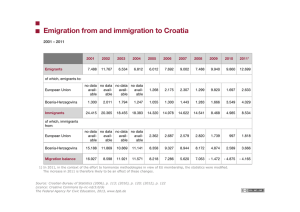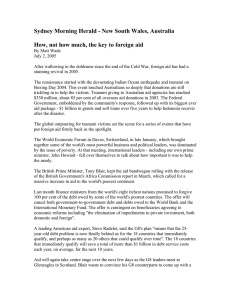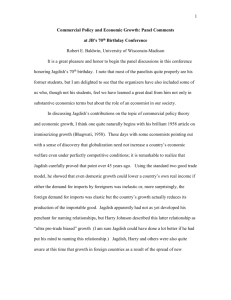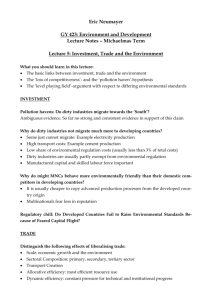By John Douglas Wilson Department of Economics
advertisement
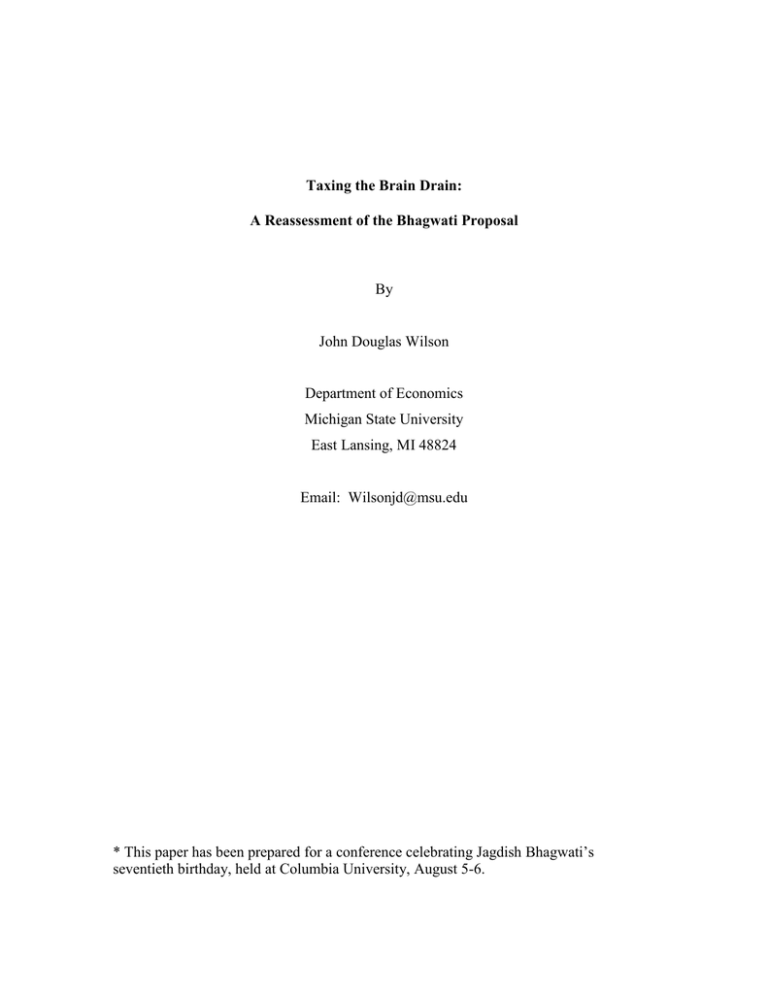
Taxing the Brain Drain: A Reassessment of the Bhagwati Proposal By John Douglas Wilson Department of Economics Michigan State University East Lansing, MI 48824 Email: Wilsonjd@msu.edu * This paper has been prepared for a conference celebrating Jagdish Bhagwati’s seventieth birthday, held at Columbia University, August 5-6. 1. Introduction It has now been more than thirty years since Jagdish Bhagwati issued his controversial proposal for “taxing the brain drain.” In its various forms, this proposal would enable developing countries to receive revenue from taxes levied on emigrants residing in developed countries. His original proposal (Bhagwati, 1972) was followed by two edited volumes (Bhagwati, 1976a and 1976b) that investigated the economic and legal issues that it raised. Another edited volume (Bhagwati and Wilson, 1989) looked at migration and tax policy more generally, including the problems that emigration creates for the source country’s tax policy when the source country is unable to tax emigrants. The literature on the brain drain has continued to grow in recent years, and there has been an outpouring of research on the issues associated with taxation in the presence of international factor mobility. In addition Bhagwati’s views have also evolved since the original proposal, including a greater recognition of the political and administrative problems involved in extending a country’s tax system to include emigrant incomes. But his basic argument for taxing the brain drain has remained remarkably constant. Recently, he has written, “Enhancing these good effects [of skilled emigration] requires that countries such as India and Taiwan adopt the diaspora model, extending a warmer embrace to their nationals abroad…However, the diaspora approach is incomplete unless the benefits are balanced by some obligations, such as the taxation of citizens living abroad…Estimates made by scholars…demonstrate that even a slight tax on Indian nationals abroad would substantially raise Indian government revenues” (Bhagwati, 2004, p. 215). In this paper, I reassess Bhagwati’s proposal, using theoretical developments on international taxation that came after it was first put forth. I find that the proposal withstands some important arguments that have been made against it. The proposal remains remarkably valid after more than thirty years. I begin by describing Bhagwati’s proposal and the reasoning behind it. In Section 3, I argue that the proposal is supported by the literature on optimal income taxation in an open economy. This literature assumes that the goal of government decision-makers is to maximize the well-being of their citizens (which may include emigrants). Since violations of this assumption have 1 been a major concern, Section 4 demonstrates that a brain-drain tax may still be desirable in the case of “non-benevolent governments.” Section 5 concludes. 2. The Proposal An initial form of the proposal, as described in Bhagwati and Dellalfar (1973), called for a tax on the incomes of “professional emigrants” from developing countries into developed countries. In its preferred form, the tax would be collected “under UN auspices,” with the aid of the tax authorities in the host developed countries. It would be levied for only a “reasonable period,” such as an emigrant’s first ten years in the host country. The UN would route the revenue to the countries of origin, except that “corrupt and dictatorial” countries would not receive revenue. Instead, it would be dispersed to developed countries using the usual criteria for developmental spending. It became apparent that enormous practical difficulties would be encountered in the implementation of such a tax, including the likelihood that attempts to involve the U.S. tax authorities in its collection would result in its being declared unconstitutional because it discriminated against aliens. In later writings, Bhagwati responded by arguing that the tax could be collected by developing countries, using the type of “global tax system” employed by the U.S. and a few other countries, whereby the incomes of citizens at home and abroad are both taxed (see, e.g., Bhagwati, 1979). With the tax collected in this manner, its rationale rests on a comparison of global tax and scheduler tax systems, where the latter is based on residences, rather than nationality. In general, there exist considerable opportunities for individuals engage in tax avoidance and evasion activities that reduce or eliminate their tax payments on income earned abroad. The use of a global tax system to tax the brain drain still requires some cooperation of developed countries, including sharing of tax information. Such cooperation has proved difficult to obtain. Bhagwati (1979, p. 62-63) emphasizes the equity aspects of a brain-drain tax. The basic idea is that skilled migrants typically earn economic rents, given the stiff immigration restrictions in developed countries, coupled with the relatively high returns to skill in developing countries. The rationale for taxing these rents then follows from the usual equity arguments behind progressive taxation – arguments that are consistent 2 with the welfare calculus of modern welfare economics. Of course, there remains the issue of why it should be the country of origin that subjects emigrants to its progressive tax system, rather than only the destination country. Here, Bhagwati (1979, p. 63) emphasizes the increased mobility of highly-skilled individuals, coupled with their tendency to retain their national status and associated rights, including often the right to vote. If emigrants are not taxed, then we have “representation without taxation” for the source country. While Bhagwati and Dellafar (1973) put forth this equity rationale for a braindrain tax, they also stressed the use of the tax to compensate developing countries for the losses experienced by those natives left behind. Bhagwati and Hamada (1974, 1975) developed theories of how these losses might occur, using models with unemployment. As an alternative to a tax collected from immigrants, Bhagwati has also discussed methods from transferring income from developed countries to developing countries to compensate the latter for losses caused by the brain drain (e.g., Bhagwati, 1976, Chapter 1). But he has long recognized that the magnitude and existence of such losses are highly uncertain, and therefore viewed the gains that developed countries experience from the brain drain as a better justification for brain-drain-related transfers (Bhagwati, 1979). Recent literature has emphasized the important gains for developing countries from high-skilled migration, which may arise from the resulting remittances and increased technology transfers, along with increased incentives for residents of developing countries to invest in human capital (Stark and Wang, 2002). Bhagwati (2004) emphasizes differences across countries in the degree to which they benefit or lose from the brain drain. Relatively small countries in Africa, from which a large fraction of skilled natives emigrate, can be expected to lose, whereas large developing countries are in a position to gain. In any case, Bhagwati has been careful not to let his proposal rest on the existence of losses to developing countries. A central issue in the assessment of a brain-drain tax is the behavior of developing-country governments. An important argument against a brain-drain tax has been that non-benevolent LDC governments would use the tax as another source of revenue for wasteful expenditures. I discuss this issue below, but first I discuss the theoretical arguments for the tax under the assumption that governments are benevolent. 3 3. The Case for a Tax on Emigrant Incomes The literature on optimal income taxation in an open economy has built a case for home-country taxation of skilled emigrants by analyzing the difficulties in collecting a progressive income tax when emigrants cannot be taxed. In the standard model of income taxation in a closed economy, as developed by Mirrlees (1971), an income tax is used to redistribute income from high-skilled workers to low-skilled workers. The goal is to maximize a social welfare function that includes as arguments the utilities of all workers. There exists an equity-efficiency tradeoff, because the income tax distorts the supply of labor. Bhagwati and Hamada (1982) and Wilson (1980, 1982) extend the Mirrlees model to an open economy, where emigration is possible, but unlike Mirrlees, they restrict the income tax to be linear.1 Their common message is that that the emigration by high-skilled workers leads to a less egalitarian tax system. The basic idea is that the outflow of workers caused by an increase in their tax payments creates a welfare loss, because the home country loses these tax payments. To limit this revenue loss, the country should reduce its taxation of highly-skilled natives, leading to a less egalitarian tax structure. A similar message occurs from Wilson’s (1992) analysis of optimal nonlinear income taxation under emigration. For all of these comparisons, the weight that a citizen receives in the measurement of social welfare is independent of whether the individual chooses to emigrate. It is the desire to avoid losing the tax revenue from high-income taxpayers that leads governments to implement a less egalitarian tax structure. The extent to which high-income workers should be taxed in an open economy depends on how elastic emigration is with respect to changes in source-country taxes. In the limit, where the elasticity is infinite, the only tax collected from the mobile-skilled should equal the cost of providing an additional skilled resident with public goods and services [see Wilson (2005a) for additional discussion]. In other words, countries would be unable to use taxation as a redistributive device if labor were perfectly mobile. A similar conclusion has emerged from the literature on the “Tiebout hypothesis:” the 1 These papers, along with the paper by Mirrlees (1982) that is discussed below, are reprinted in Bhagwati and Wilson (1989). See Wilson (2005a) for a more extensive review of these and related papers. 4 mobility of households leads to an efficient provision of public goods by local governments, but it prevents these governments from redistributing income. Allowing the home country to tax high-skilled emigrants enables it to increase its taxation of those high-skilled natives remaining at home without causing a revenuereducing outflow of these individuals. Fewer leave because they are taxed abroad, and those that do leave continue to contribute to the home country’s treasury. Thus, braindrain taxes can be justified not just as a means of redistributing income from high-income emigrants to lower-income residents, but also as a way of increasing the ability of a country to tax high-income residents. The case for a brain-drain tax is further strengthened by the analysis by Mirrlees (1982) of an optimal nonlinear income tax model in which both residents and emigrants are taxed. In this model, individuals have an opportunity to exit the tax system, interpreted as giving up their citizenship after emigrating. Nevertheless, Mirrlees finds that emigrants should still be taxed at relatively high rates. Indeed, he presents calculations where, comparing an emigrant and resident who are equally well off, the emigrant’s tax payments should be at least as high as the resident’s tax payments. The Mirrlees model is particularly noteworthy as a theoretical basis for a braindrain tax, because it includes the economic rents that some migrants receive. This is done by allowing some individuals to have access to high incomes abroad (net of monetary and psychic migration costs), relative to their incomes at home. In line with Bhagwati’s reasoning, such rents help lead to high optimal taxes on emigrants, even though these rents vary widely across emigrants, and although individuals also possess heterogeneous abilities to opt out of the tax system. One limitation of Mirrlees’ analysis is the absence of an explicit model of host country restrictions on immigration, which Bhagwati cites as a major reason for such rents. It would be useful to construct a model of this type. By including the costly activities that potential immigrants undertake to enter their host countries (e.g., more costly or less-suitable forms of education, or unemployment while waiting for entry), actual rents might be lower than initially perceived. As described above, recent literature on the brain drain suggests that it benefits those left behind in developing countries. But the demonstration that such benefits exist 5 does not imply that unfettered migration maximizes their value. Thus, whereas Stark and Wang (2002) demonstrate that emigration opportunities stimulate human capital investment in the emigrants’ home countries, they also find that these countries would benefit from restrictions on emigration.2 A brain-drain tax would have a similar effect, by reducing incentives to migrate. Moreover, regardless of the responsiveness of migration rates to a brain-drain tax, its justification as a redistributive device would remain. Thus, this more recent literature should not be viewed as providing a convincing argument against taxing the brain drain. 4. Non-Benevolent Governments A major concern about a brain-drain tax has been the possibility that some developing countries would abuse it. At the time the tax was proposed, there were concerns with “exit taxes” imposed by communist countries. On more philosophical grounds, Harry Johnson objected to requiring individuals who chose to leave a developing country to continue to pay taxes to this country, particularly since many developing countries were dictatorships.3 But Bhagwati (1979) remarks that versions of the tax calling for it to be collected only from those emigrants retaining citizenship are not subject to such criticisms. These individuals could opt out of paying the tax by severing their ties with their home countries. Related criticisms have been raised by Hufbauer (1989). He cites Tiebout’s theory, where the opportunity to “vote with one’s feet” causes local governments to be efficiently respond to the preferences of their residents. According to Hufbauer, “The ability of an individual to emigrate affords both an escape hatch and a defense against political and economic oppression at the national level” (1989, p. 87). In his view, taxes on emigrant incomes represent restrictions on emigration, albeit mild forms. To the extent that a tax on the brain drain would inhibit emigration, it would reduce the ability of emigration to limit the behavior of local governments. 4 2 See Stark et al. (2005) for further analysis. Reported by Bhagwati (1979, p. 67). 4 Hufbauer also objects to such taxes because emigrants are not receiving the public goods financed by these taxes, and they have severed their cultural connections. The latter assertion is increasingly questionable, however, and emigrants do benefit from the “option value” of the right to return to their home countries and receive public good benefits. 3 6 Such arguments may be addressed using a model in Bhagwati and Wilson (1989, Chapter 1). We sketch a model in which government officials in the home country care not only about the well-being of its citizens, measured by their “real income” (including emigrant income, net of emigration costs), but also about their own real income, given by the excess of tax revenue over expenditures on productive public expenditures, which increase the well-being of residents. To increase their income, officials must either raise taxes or reduce productive public expenditures, both of which reduce citizen income. But then some citizens will emigrate, causing a drop in tax revenue if the home country cannot tax their incomes abroad, and this lost revenue will lead to a further decline in citizen income. In other words, potential emigration creates a substitution effect by increasing the price of the officials’ income, measured in units of foregone citizen income. If the home country could tax immigrant incomes, then the revenue loss from emigration would decline, thereby reducing or eliminating this desirable substitution effect. However, this tax would also provide an additional source of income for financing both citizen income and the officials’ income. In other words, taxing emigrants creates an income effect, which may offset the substitution effect. The basic idea here is that in the absence of a tax on emigrants, countries are forced to “compete” for residents by reducing “waste” in government. This competition may then be desirable, a possibility that has been pursued further in papers by Gordon and Wilson (2003) and Wilson (2005b) on the desirability of tax and expenditure competition when there exist waste in government. As argued by Bhagwati and Wilson (1989), the desirability of this competition for the citizens of developing countries may be offset by the revenue losses resulting from emigration. Thus, the welfare effects of a brain-drain tax can go either way. It is interesting to note here that Bhagwati’s early view that the tax revenue could be distributed by the UN to the host developing countries has the potential to foster both beneficial tax competition while providing these countries with income generated by taxes on emigrants. The trick would be to design the criteria for distributing the tax revenue so that an increase in any given country’s emigration rate did not significantly increase the revenue transferred to that country (see Bhagwati and Wilson, 1989, Chapter 1). In other words, the pattern of revenue disbursements could be based on 7 “initial” emigration rates, but countries could not perceive that more emigration would result in more revenue. In a world with changing migration patterns, such a system might be difficult to maintain, unless the revenue transfers were undertaken for developmental needs that were largely independent of these changes in migration patterns. But there is an additional argument in favor of Bhagwati’s later proposal for implementing the brain-drain tax as part of a “global tax system” faced by all citizens, regardless of where they reside. Here the taxation of emigrants replaces incentives for the countries to compete for residents with incentives to now compete for citizens. Specifically, the ability of a citizen to avoid the tax by giving up citizenship in the home country provides the country’s government with incentives to engage in policies that are agreeable to citizens residing abroad. For example, if the taxes collected from these emigrants are largely wasted, then the citizen will be less likely to plan to return home for extended periods of time, in which case citizenship becomes less important. There is a tradeoff here. Allowing emigrants to avoid taxes by surrendering their citizenship limits the ability of the home government to tax these individuals. On the other hand, such avoidance activity limits the power of non-benevolent governments to some extent. As a result, incorporating this tax-avoidance feature into a brain-drain tax may increase its desirability. In fact, Bhagwati’s main rationale for a brain-drain tax – as a method of taxing the “rents” received by emigrants – suggest that this form of the tax should be used when developing-country governments are not benevolent. As noted above, he has argued that these rents result from the tight restrictions that developed countries impose on immigration from developing countries. Given such restrictions, the relevant migration elasticities are likely to be quite low with respect to changes in developing-country tax and public expenditure policies. Low elasticities reduce the degree to which a developed country needs to compete for residents through low taxes and desirable public expenditures. On the other hand, the elasticity of citizenship with respect to these developing-country policies can remain sizable, though migration elasticies are low. Given this combination of elasticities, a brain-drain tax will actually enhance incentives 8 for developing countries to engage in welfare-improving tax and expenditure competition. To conclude, Bhagwati’s proposal to use a global tax system, based on citizenship rather than residence, as a means of taxing the brain drain, seems to be well-suited for addressing concerns about the functioning of developing-country governments. 5. Concluding Remarks I have argued that Bhagwati’s proposal for a brain-drain tax survives major objections that have been levied against it, including the view that it would eliminate desirable competition for residents. Note, in addition, that governments compete not just for residents, but also for capital investment, and the latter form of competition is not directly affected by a brain-drain tax. Recent research has presented new arguments for the absence of a “brain-drain problem,” but this development does not eliminate the desirability of a brain-drain tax, which was based more on the existence of the “brain-drain phenomenon.” A major stumbling block in the implementation such a tax continues to be the administrative problems associated with collecting it. But these problems exist whenever taxes are levied on foreign-source income. Without the cooperation of host country governments, it is most difficult for the source country to collect these taxes. A large element of such cooperation would include information-sharing among governments, a topic that is now being actively researched (e.g., Keen and Ligthart (2005)). Like other important policy initiatives, Bhagwati’s proposal is not only wellgrounded in existing economic theory, but also points to holes in the theory that need to be filled. Research inspired by this proposal should continue to further our understanding of how to design tax policies for an increasingly integrated world economy. 9 References Bhagwati, Jagdish N. “The United States in the Nixon Era: The End of Innocence,” Daedalus (1972). Bhagwati, Jagdish N. (ed.) Taxing the Brain Drain, Vol. 1: A Proposal, Amersterdam: North-Holland (1976a). Bhagwati, Jagdish N. (ed.) The Brain Drain and Taxation, Vol. 2: Theory and Empricial Analysis, North-Holland (1976b). Bhagwati, Jagdish N. “International Migration of the Highly Skilled: Economics, Ethics and Taxes,” Third World Quarterly, 1, 17-30 (1979). Bhagwati, Jagdish N. In Defense of Globalizaton, New York: Oxford University Press (2004). Bhagwati, Jagdish N., and Dellafar, “The Brain Drain and Income Taxation,” World Development 1 (1973). Bhagwati, Jagdish N., and Hamada, Koichi. “The Brain Drain International Integration of Markets for Professionals and Unemployment: A Theoretical Analysis,” Journal of Development Economics, 1, 19-24 (1974). Bhagwati, Jagdish N., and Hamada, Koichi. “Domestic Distortions, Imperfect Information and the Brain Drain,” Journal of Development Economics, 2, 139-53 (1975). Bhagwati, Jagdish N., and Hamada, Koichi. “Tax Policy in the Presence of Emigration,” Journal of Public Economics, 18, 291-317 (1982). Bhagwati, Jagdish N., and Wilson, John D. (eds.). Income Taxation and International Mobility, Cambridge, MA: M.I.T. Press (1989). 10 Hufbauer, Gary Clyde, “The State, the Individual, and the Taxation of Economic Migration,” in J.N. Bhagwati and J.D. Wilson (eds.), Income Taxation and International Mobility, Cambridge, MA: M.I.T. Press (1989). Keen, Michael, and Ligthart, Jenny, “Information Sharing and International Taxation: A Primer,” International Tax and Public Finance, forthcoming (2005). Mirrlees, James A. “An Exploration in the Theory of Optimal Income Taxation,” Review of Economic Studies, 38, 175-208 (1971). Mirrlees, James A. “Migration and Optimal Income Taxes,” Journal of Public Economic, 18, 319-341 (1982). Stark, Oded, and Wang, Yong. “Inducing Human Capital Formation: Migration as a Substitute for Subsidies,” Journal of Public Eocnomics, 86, 29-46 (2002). Stark, Oded; Casarico, Alessandra; Devillanova, Carlo; and Uebelmesser, Silke. “The New Economics of the Brain Drain: Mapping the Gains,” Unpublished manuscript (2005). Wilson, John D. "The Effect of Potential Emigration on the Optimal Linear Income Tax," Journal of Public Economics 14, 339-353 (1980). Wilson, John D. "Optimal Linear Income Taxation in the Presence of Emigration," Journal of Public Economics, 18, 363-379 (1982b). Wilson, John D. "Optimal Income Taxation and International Personal Mobility," American Economic Review, Papers and Proceedings, 82, 191-196 (1992). Wilson, John D. “Income Taxation and Skilled Migration: The Analytical Issues,” Unpublished manuscript, Michigan State University (2005a). Wilson, John D. “Welfare-Improving Competition for Mobile Capital,” Journal of Urban Economics, 57, 1-18 (2005b). 11 Wilson, John D., and Gordon, Roger. “Expenditure Competition,” Journal of Public Economic Theory, 5, 399-417 (2003). 12
